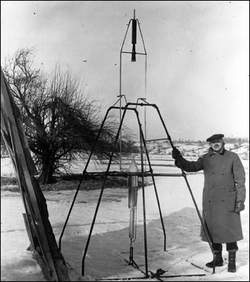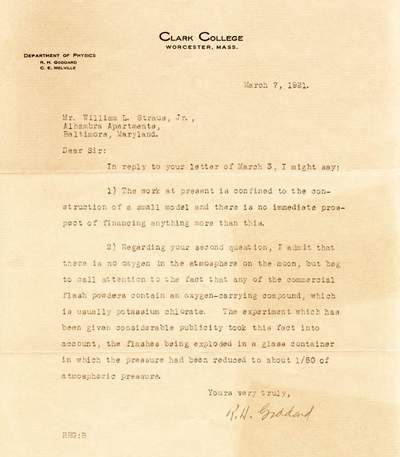First Liquid-Fuel Rocket Being Cloned at NASA Marshall
A team of engineers from NASA's Marshall Space Flight Center in
Huntsville (AL), is hard at work on a project to "recreate history"
by building a pair of replicas of the world's first liquid-fueled
rocket. One of them is a working version that is undergoing ground
tests at the Marshall Center this summer.
 The original rocket, designed and
built by rocket engineering pioneer Robert H. Goddard, was first
flown March 26, 1926, in Auburn (MA). That accomplishment is
considered the first step in opening the door of modern rocketry.
The 10-foot rocket reached an altitude of 41 feet, while the flight
lasted only 2.5 seconds.
The original rocket, designed and
built by rocket engineering pioneer Robert H. Goddard, was first
flown March 26, 1926, in Auburn (MA). That accomplishment is
considered the first step in opening the door of modern rocketry.
The 10-foot rocket reached an altitude of 41 feet, while the flight
lasted only 2.5 seconds.
The replica project was the brainchild of Robert Sackheim,
assistant director and chief engineer for space propulsion at the
Marshall Center, and John London, technical assistant to Mr.
Sackheim. Both men were officers in the American Institute of
Aeronautics and Astronautics Alabama-Mississippi Section, and
developed this project for AIAA to help celebrate this year's
Centennial of Flight activities. According to Sackheim, the
Marshall Center was the perfect fit to take on such a challenging
project due to its history and resources in propulsion. The AIAA is
the world's largest professional engineering and science
society.
"Building replicas of Goddard's first rocket has been like an
archeological effort for us," said Tim Sanders, the Marshall
Center's technical team leader for test area operations and acting
volunteer project manager for the Goddard rocket replica team.
"History is a big part of the rocket business. Becoming more aware
of it keeps us from repeating some of the same mistakes of the
past," he said.
AIAA approached Sanders and his 22-member team of replica
volunteers, all from Marshall's Space Transportation Directorate,
late last year with the proposal to recreate Goddard's first
rocket. The Space Transportation Directorate manages numerous key
propulsion and flight research areas intended to dramatically
improve access to space and in-space transportation. Other members
of Sander's technical team included engineers Sandy Elam, Warren
Peters, Paul Dumbacher, Gary Hicks, Jay Dennis and Richard
Cooper.
Authenticity is key
The Marshall design team's plan has been to stay as close as
possible to an authentic reconstruction of Goddard's rocket. For
the working version the same propellants will be used -- liquid
oxygen and gasoline -- as available during Goddard's initial
testing and firing. The team is also trying to construct both
replicas using the original materials and design to the greatest
extent possible. By purposely using less-advanced techniques and
materials than many that are available today, the team has
encountered numerous technical challenges in testing the functional
hardware. "Since there were no original blueprints or drawings, all
we've had to rely on are photographs and notes. It's much like
piecing together a puzzle," said Sanders.
However, this faithful adherence to historical accuracy has also
allowed the team to experience many of the same challenges Goddard
faced 77 years ago, and more fully appreciate the genius of this
extraordinary man. According to London, the work of the team
represents remarkable research that is uncovering a wealth of
previously unknown information about one of the greatest
accomplishments in astronautics.

The team members also look at the replica project as an
educational resource for those who study liquid rocketry in the
future. Along with the working version, the team is creating a
full-scale model to be used for exhibit and educational purposes.
"Our hope is to provide resources for students to study liquid
rocketry 50 years from now, giving them an idea of the challenges
Goddard faced during his time," said Rebecca Farr, a Marshall
engineer who is working on the project. "Once we get things down on
paper and they see the full-scale model up close, so many more
people will be able to benefit from these efforts."
 Aero-TV: DeltaHawks Diesel Power Steps Into the Spotlight
Aero-TV: DeltaHawks Diesel Power Steps Into the Spotlight NTSB Prelim: Mooney Aircraft Corp. M20K
NTSB Prelim: Mooney Aircraft Corp. M20K ANN FAQ: Turn On Post Notifications
ANN FAQ: Turn On Post Notifications ANN's Daily Aero-Linx (12.20.25)
ANN's Daily Aero-Linx (12.20.25) Aero-News: Quote of the Day (12.20.25)
Aero-News: Quote of the Day (12.20.25)




